Audience response systems have been a classroom staple for good reason: they work. Whether it’s a quiz, a poll, or a quick check for understanding, these tools create a space for students to respond, and that’s what matters.
But as EdTech continues to evolve, these tools have found themselves in a race to be the most interactive, the most engaging, the most gamified. Some stick to the basics. Others go all out with leaderboards, emojis, and AI-powered everything.
It’s a lot to sort, through. So I did it for you.
Here’s a quick glance of the top audience response systems that actually work in real classrooms, every day. Let’s take a look:
| Audience Response System | What it Does Best | Features You’ll Love | Pricing |
|---|---|---|---|
| ClassPoint | PowerPoint-native quizzes and gamification | PowerPoint integration, AI quiz generator, leaderboard, quiz reports, web access | Free basic plan, Pro from $8/mo |
| Kahoot! | Gamified learning with a competitive edge | Real-time scoring, quiz library, word clouds, polls | Free (40 participants), from $3.99/mo |
| Quizizz | Flexible quizzes for class and homework | Self-paced quizzes, multimedia support, rich analytics | Free basic plan, Super from $19/mo |
| Mentimeter | Visual live polls and feedback | Interactive polls, word clouds, no downloads needed | Free (50 participants/mo), from $10/mo |
| Poll Everywhere | Reliable polling with various response modes | Q&A, real-time polling, presentation integration | Free (40 students), from $9/mo |
| Slido | Moderated Q&A and group discussion | Anonymous Q&A, slide integration, upvoting | Free (100 participants), from €5/mo |
| Socrative | Quick formative assessments | Exit tickets, instant feedback, Space Race game mode | Free (50 students), from $9.99/mo |
| Nearpod | Multimedia lesson interactivity | VR trips, collaborative boards, live/self-paced lessons | Free (40 students), Gold from $13.25/mo |
| Pear Deck | Google Slides-based interactivity | Google integration, anonymous responses, Drive storage | Free basic plan, Premium $149.99/year |
| Plickers | No-device classroom participation | Card-based input, quick scanning, easy to set up | Free basic plan, Pro from $5.99/mo |
| AhaSlides | Interactive slide-based quizzes and polls | Live polls, Google Slides integration, QR access | Free (50 participants), from $7.95/mo |
| Vevox | Enterprise-grade polling with LMS support | Live Q&A, LMS integration, PowerPoint plugin | Free (100 participants), from $7.75/mo |
| Wooclap | Broadest variety of interaction types | 21+ question types, collab tools, neuroscience design | Free (2 questions/session), from $6.99/mo |
1. ClassPoint
Great for: Integrating engaging quizzes directly into PowerPoint presentations
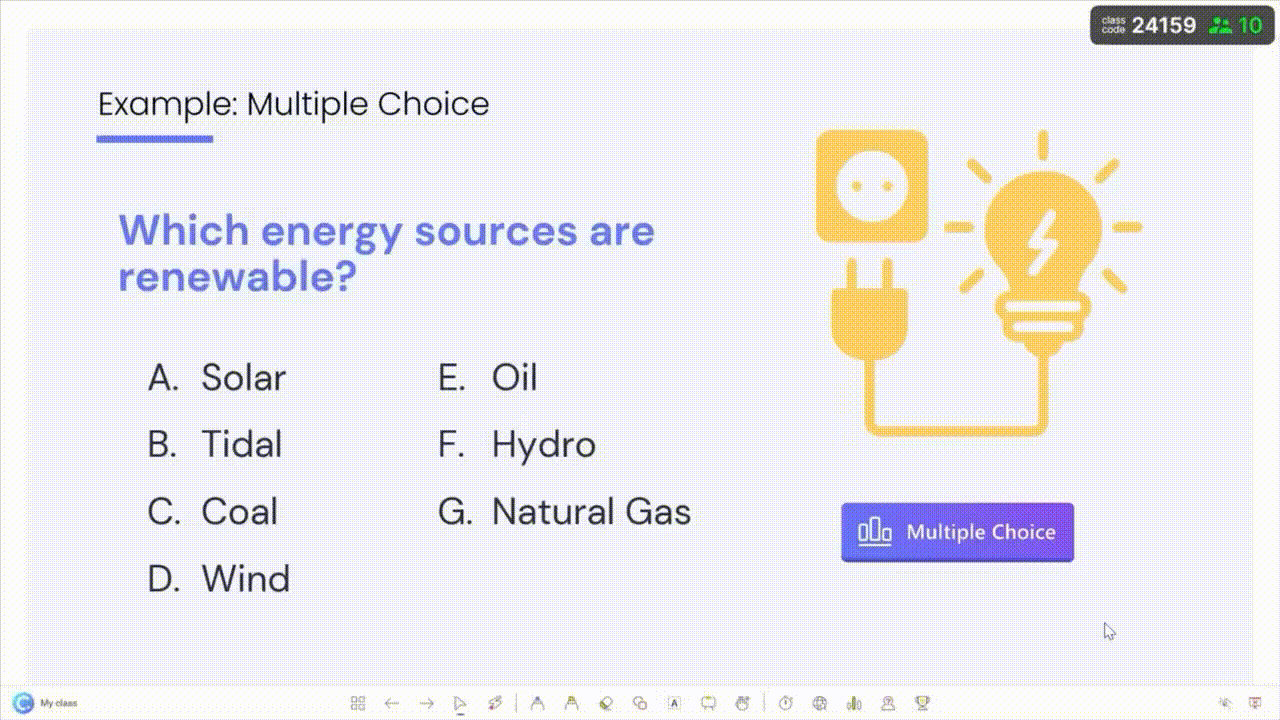
ClassPoint, I must say, is truly a top pick when talking about audience response systems. ClassPoint seamlessly integrates quizzes and interactive elements directly into PowerPoint, as it lives inside it, making lesson prep effortless and classroom interactions smooth.
You can directly embed various interactive questions, including multiple-choice, word clouds, and short-answer questions, right into your existing slides. And its PowerPoint integration means no more switching between apps.
A key feature you’d definitely enjoy is its gamification features with stars, badges, and leaderboards, that significantly boost student engagement. Plus, its AI Quiz Generator, which is a real time-saver for busy schedules. It automatically generates quiz questions from the information on your slides, so you don’t have to do them manually!
Key Features:
- PowerPoint integration: Quizzes and polls directly within slides
- AI Quiz Generator: Automatically generates quizzes from presentation content
- Gamified learning: Token system for increased student engagement
- Quiz reports: Instant insights into student understanding
- Web app: An extended access from its default PowerPoint integration
Pricing: Free plan supports up to 25 students; Pro plan starts at $8/month (billed annually) for expanded features and up to 200 students.
Take a look at this step-by-step guide on Creating a Lesson with ClassPoint from Start to Finish.
2. Kahoot!
Great for: Energizing classes through fast-paced, competitive quizzes
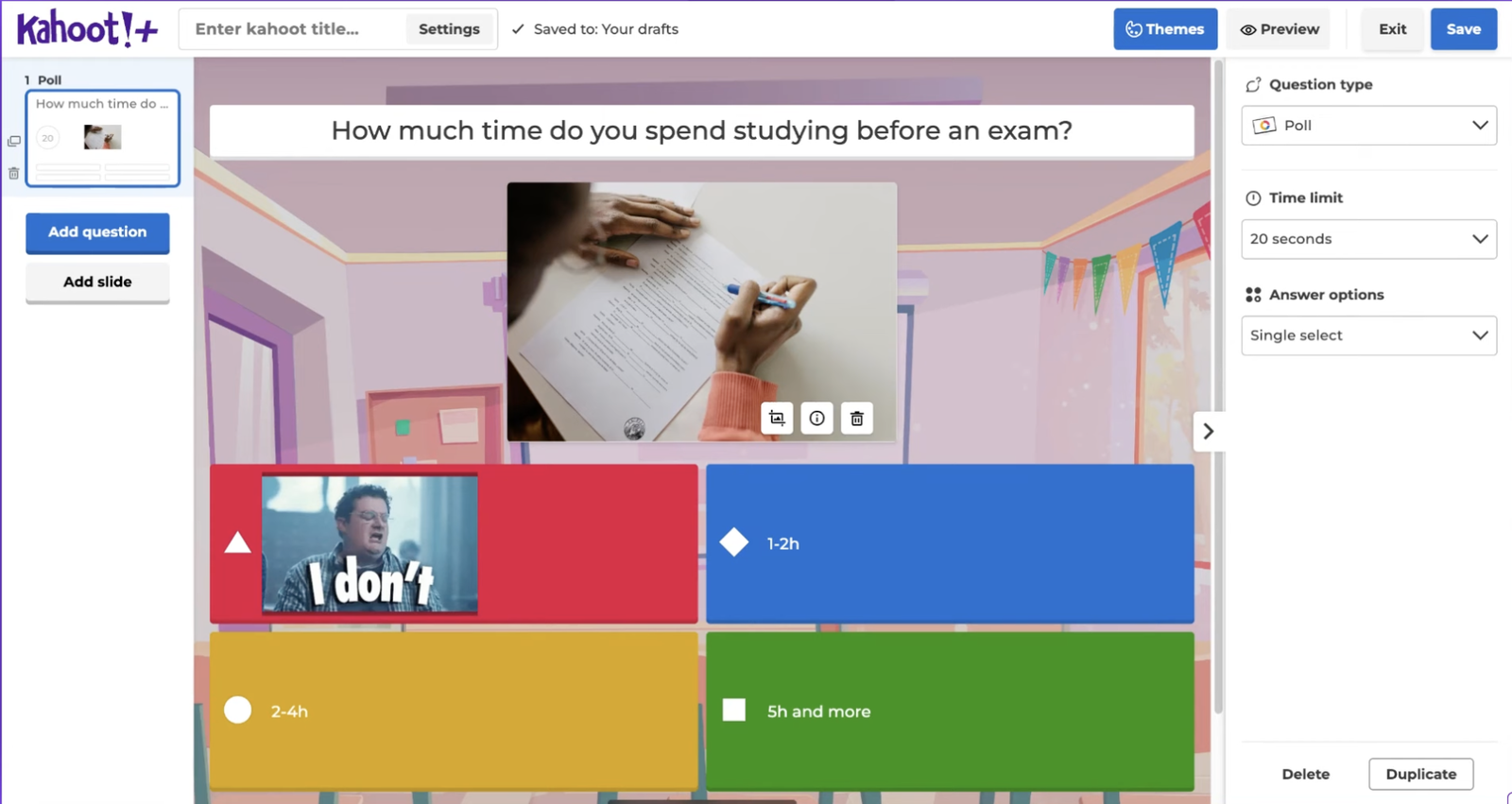
Kahoot!, truly, has been a household name and for many good reasons. It brings excitement to the classroom with engaging, competitive quizzes. It particularly stands out during review sessions, motivating students to actively participate through points and ranks.
One thing to really appreciate with Kahoot! is its vast library of ready-made quizzes, which saves significant prep time. And a true visual bonus is how students can consistently respond positively to its vibrant and playful interface.
Key Features:
- Competitive quizzes: Real-time scoring keeps engagement high
- Extensive quiz library: Millions of pre-made quizzes available
- Versatile interactions: Polls, word clouds, and open-ended questions
Pricing: Free plan allows up to 40 participants; Kahoot!+ Bronze starts at $3.99/month (billed annually) for advanced features and up to 50 participants.
We've put ClassPoint and Kahoot! side by side with our quick comparison guide here.
3. Quizizz
Great for: Versatile quizzes ideal for both classroom and homework use

Quizizz offers flexibility by supporting live classroom activities as well as student-paced homework. It uniquely combines competitive elements with the comfort of individual pacing, which is perfect especially for students who prefer less pressure compared to what real-time tools like Kahoot! brings to the learning process.
Personally, I find its detailed analytics helpful in pinpointing areas requiring additional review. Not a lot of audience response systems have this much. The colorful, engaging interface further adds to its appeal as well.
Key Features:
- Student-paced quizzes: Allows for individual learning speed
- Custom multimedia questions: Include images and diagrams
- Rich analytics: Detailed performance insights
Pricing: Free plan offers basic features with limited content storage; Super plan starts at $19/month (billed annually) for unlimited storage and advanced tools.
Check out this curated list of 11 Best Quizizz Alternatives.
4. Mentimeter
Great for: Visual and instant feedback during classes
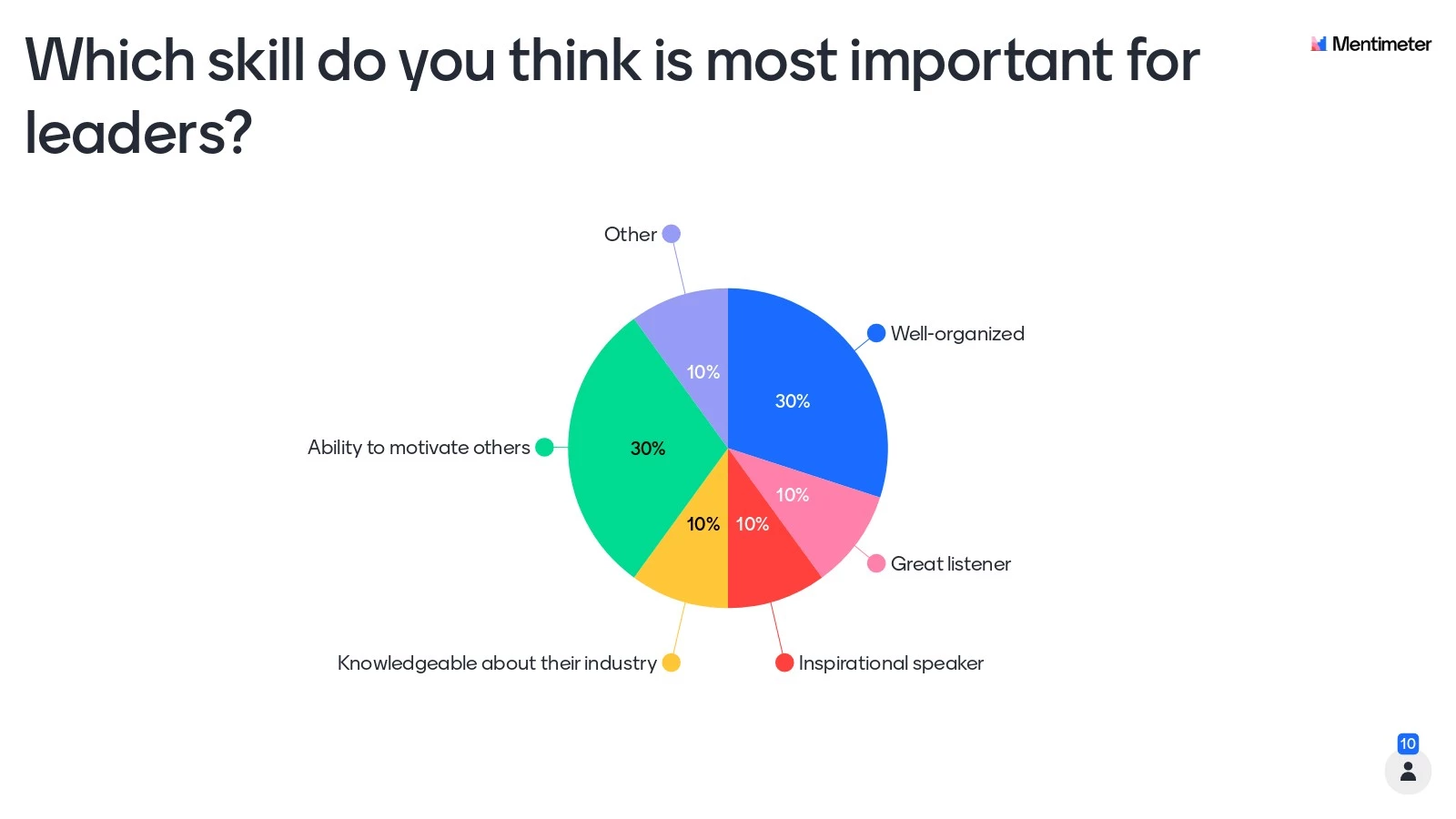
Mentimeter has been particularly effective in visualizing student feedback through polls and word clouds. It is user-friendly and does not require downloads, making spontaneous use during class discussions practical and straightforward.
It works exceptionally well for gathering opinions anonymously, encouraging even shy students to participate actively.
Key Features:
- Interactive polls and quizzes: Immediate visual results
- Browser-based: No downloads or installations required
- Real-time word clouds: Visualize collective responses instantly
Pricing: Free plan allows up to 50 total participants/month; Education Basic starts at $10/month (billed annually) for unlimited sessions and advanced features.
Mentimeter, while a great tool, has some good competition along its same vein. Have a look at the Top 10 Powerful Mentimeter Alternatives (In-Depth Analysis).
5. Poll Everywhere
Great for: Reliable and diverse classroom interactions
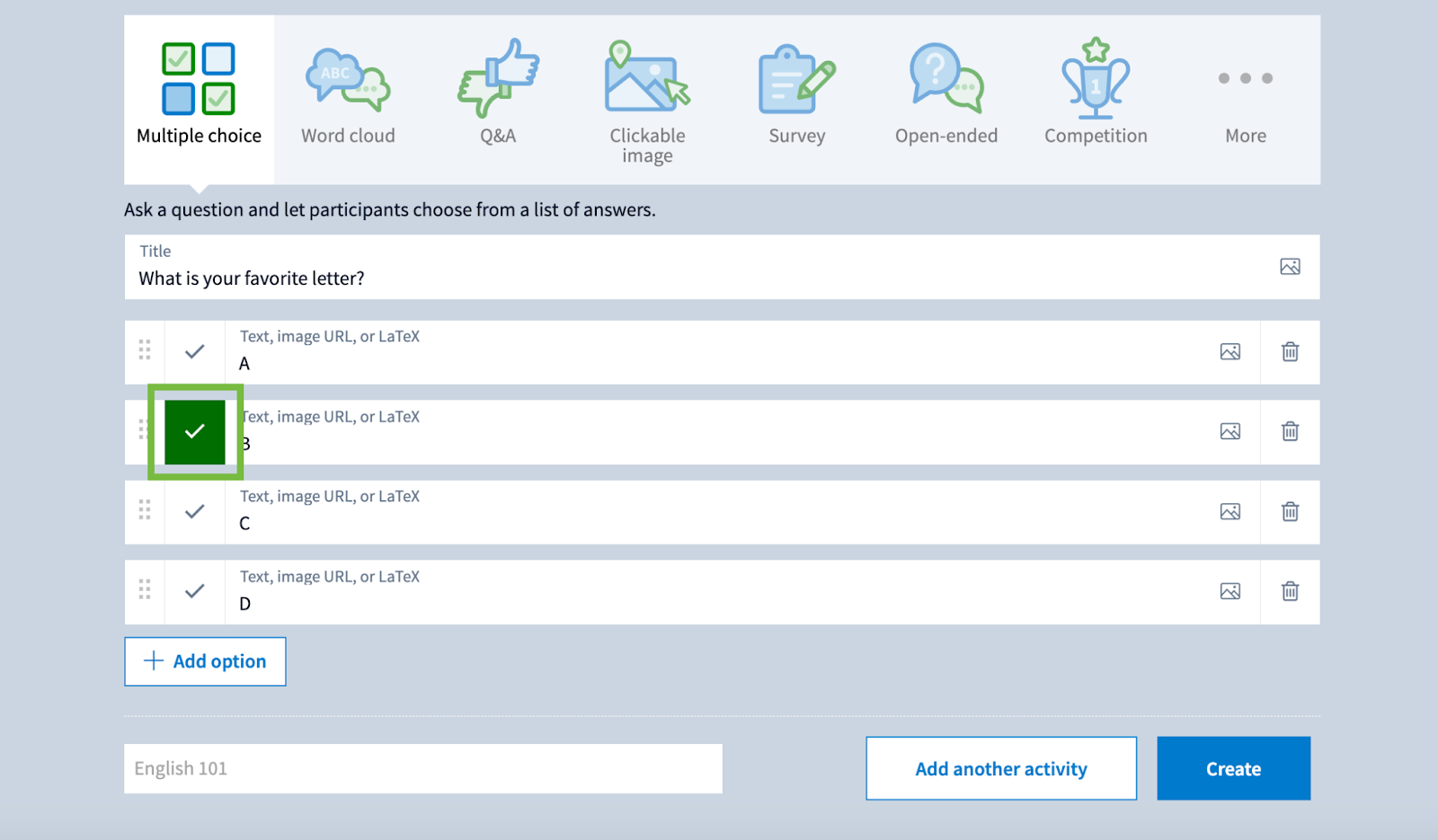
One of the original audience response systems, Poll Everywhere remains a favorite in classrooms and lecture halls. It’s a web-based platform that lets participants respond to questions via phone, laptop, or text message, with live results.
However, Poll Everywhere might require more setup compared to simpler tools like Mentimeter, particularly when handling larger groups.
Key Features:
- Real-time polling and Q&A: Instantly gather student insights
- Anonymous participation: Encourages more open student responses
- Integrated presentation software: Works smoothly within existing presentations
Pricing: Free plan supports up to 40 students per poll; Lecture plan starts at $9/month (billed annually) for larger classes and enhanced support.
Speaking of polls, you might want to explore further on this list of 7 Free Polling Apps for Classroom Engagement and Instant Feedback.
6. Slido
Great for: Effective moderation of classroom discussions
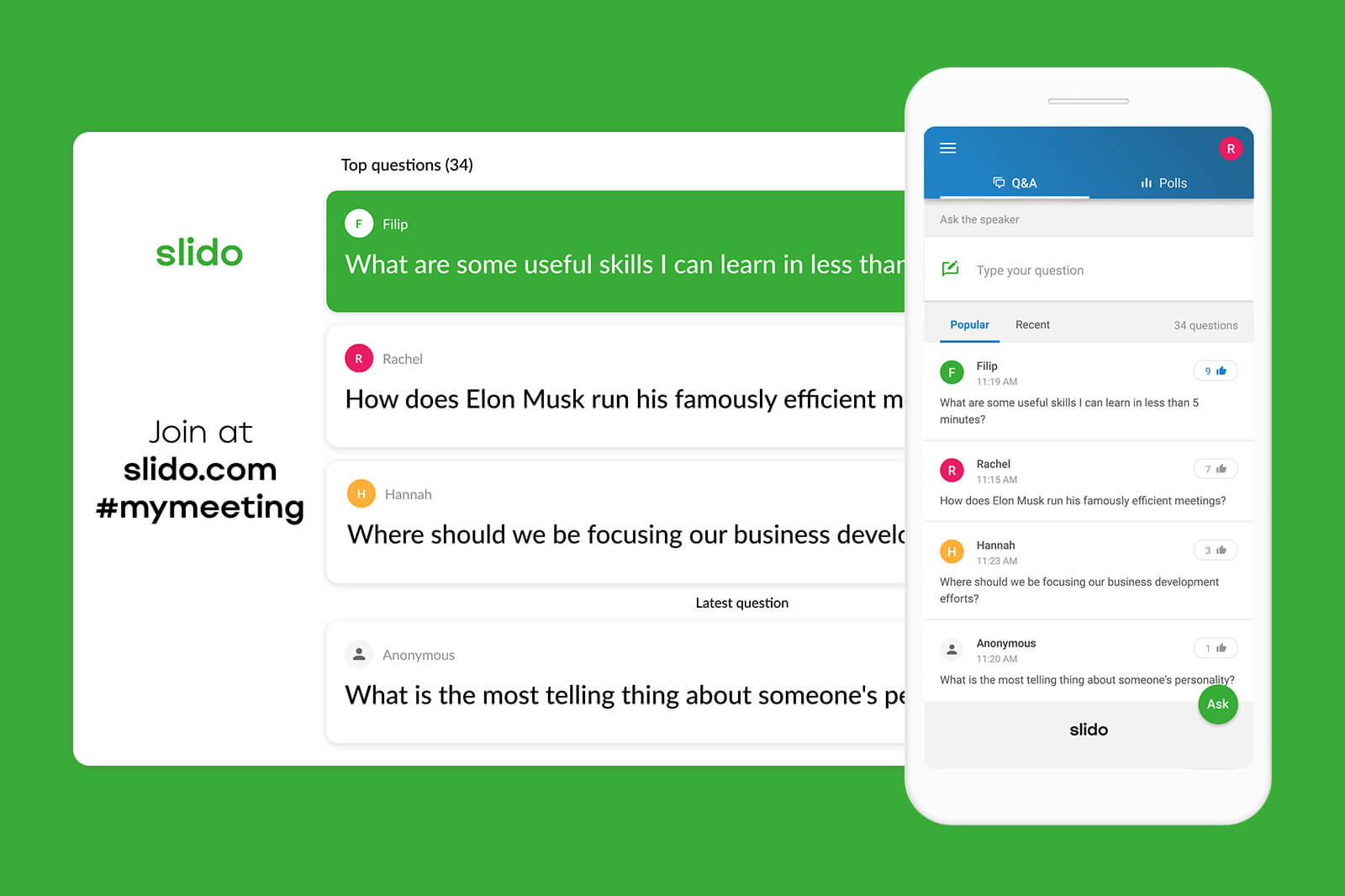
Slido is excellent for moderating large classroom discussions. Students can submit and upvote questions anonymously, ensuring that important queries get addressed first. If you’re particularly looking among audience response systems for a tool that can improve student discourse, Slido is for you.
Key Features:
- Moderated Q&A: Students can anonymously submit and prioritize questions
- Seamless integration: Compatible with various presentation platforms
- Live quizzes: Quick understanding checks
Pricing: Free plan supports up to 100 participants with limited polls; Engage (Education) plan starts at €5/month (billed annually) for unlimited polls and advanced features.
Making classrooms interactive is one thing Slido stands on business for. But, it isn't the only one. Here are 8 Best Slido Alternatives to Make Your Classroom More Interactive.
7. Socrative
Great for: Quick and straightforward formative assessments
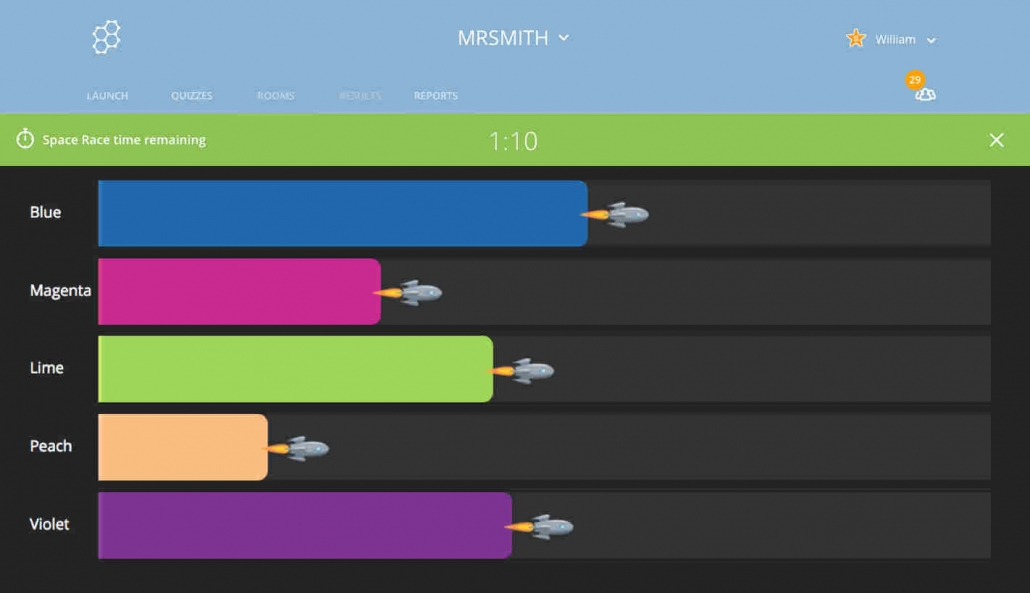
Socrative effectively handles on-the-spot formative assessments, providing instant grading and clear insights into student understanding. It offers straightforward usability, ideal for quick checks of comprehension or exit tickets.
The “Space Race” game mode, in particular, adds an enjoyable competitive element, which can do a lot more than you can imagine in student motivation.
Despite its lack of flashy visuals compared to Kahoot! or Quizizz, the straightforward design ensures simplicity and ease of use.
Key Features:
- Rapid quiz creation: Instant student assessment
- Real-time analytics: Quick review of class performance
- Device compatibility: Accessible across all student devices
Pricing: Free plan supports up to 50 students and limited quizzes; Essentials plan starts at $9.99/month (billed annually) for expanded capabilities.
8. Nearpod
Great for: Interactive multimedia lessons
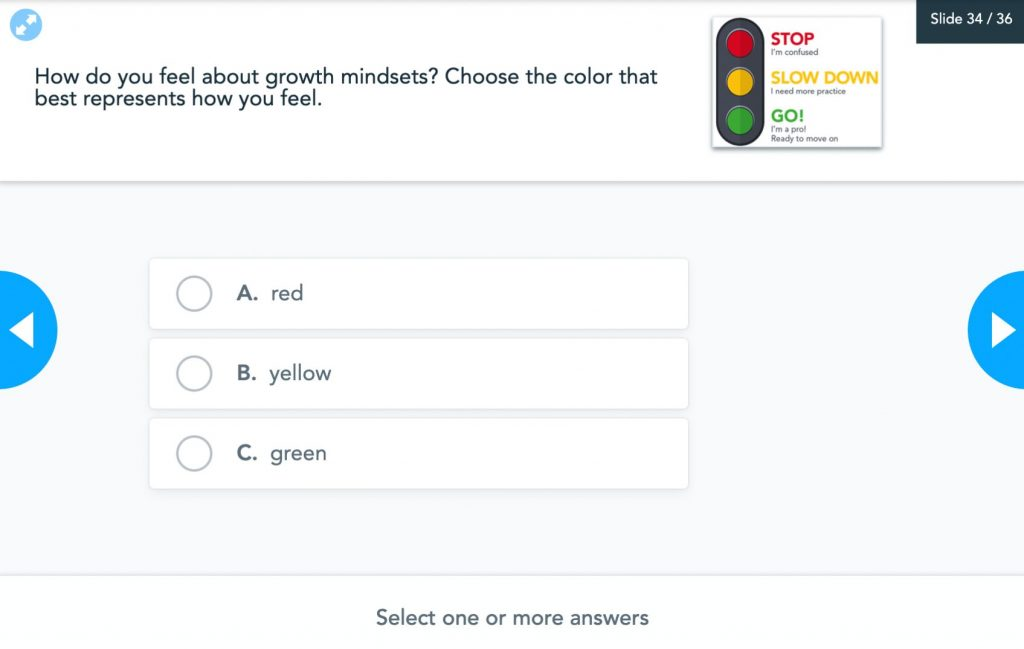
Nearpod integrates various multimedia and interactive elements directly into presentations. Students engaged deeply with content through diverse activities like virtual field trips and collaborative bulletin boards, going beyond traditional quizzes.
You may also choose between synchronous (teacher-led) or asynchronous (student-paced) lesson modes, so you can be more flexible in different teaching scenarios.
Its comprehensive nature may require initial learning effort, but its usability justifies the investment in the time you’d need learning it!
Key Features:
- Diverse interactive activities: Quizzes, VR tours, collaborative boards
- Flexible lesson delivery: Live and self-paced options
- Immediate analytics: Insights into student engagement
Pricing: Free Silver plan supports up to 40 students; Gold plan costs $13.25/month (billed annually) for larger classes and added tools.
9. Pear Deck
Great for: Seamless interactivity within Google Slides
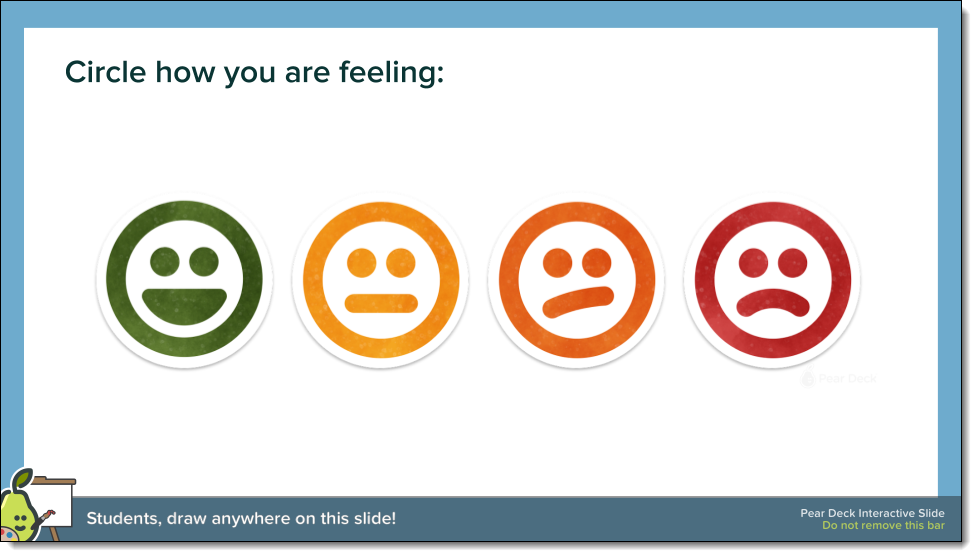
Pear Deck integrates effortlessly with Google Slides, ensuring all students actively participate through embedded interactive questions. Its seamless Google integration makes it highly suitable for classrooms already in the Google ecosystem. Like ClassPoint in PowerPoint, audience response systems that can easily be integrated with already-familiar presentation tools always win.
A quick bonus: its automatic saving of responses to Google Drive simplifies post-class review and follow-up.
Key Features:
- Google Slides integration: Direct question embedding
- Anonymous student responses: Encourages honest student input
- Automatic data storage: Saves responses directly in Google Drive
Pricing: Basic free plan; premium plans at $149.99/year.
10. Plickers
Great for: Low-tech, quick classroom quizzes
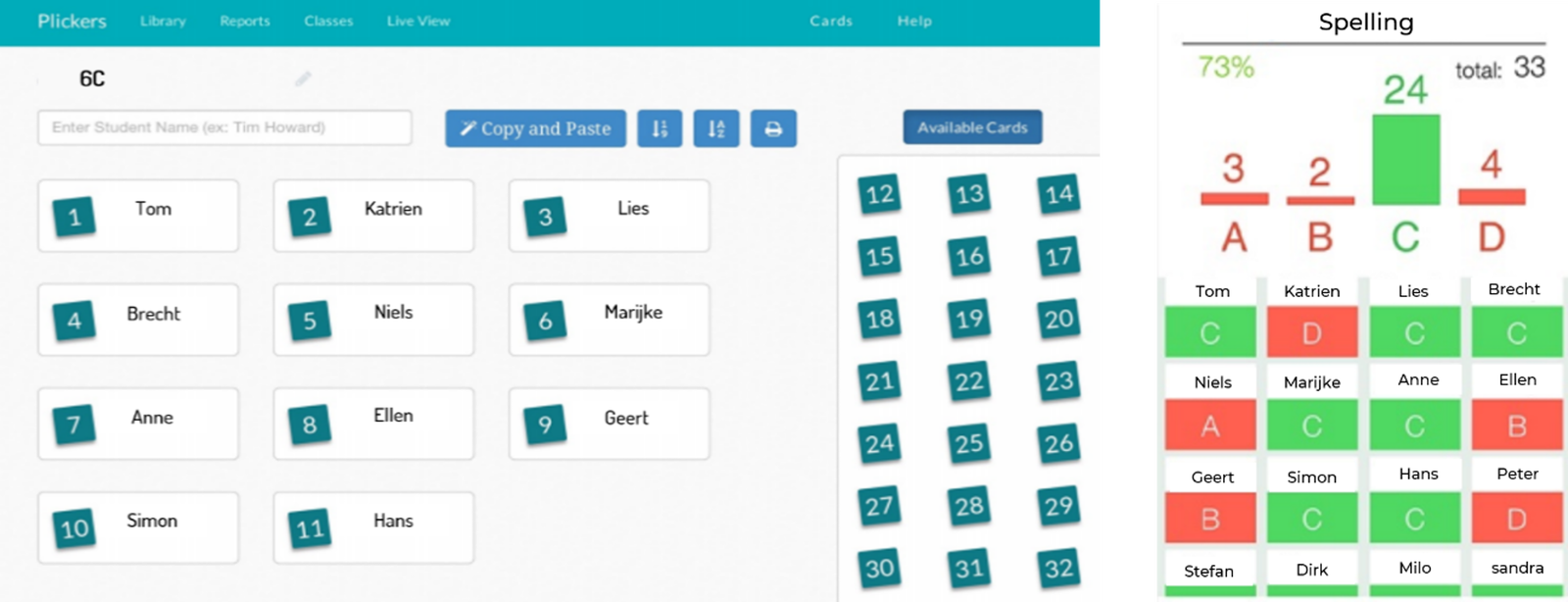
Plickers offers a clever low-tech twist on audience response. It’s perfect for classrooms with limited student devices, because only the teacher needs a smartphone or tablet. Students answer by holding up printed cards, and the teacher’s device scans the room to record responses.
If you’re looking for an audience response system that does not require individual student devices, you’re in for a treat with Plickers. While limited to multiple-choice questions, Plickers’ ease of use remains effective for everyday classroom use.
Key Features:
- Low-tech participation: Uses only printed cards and teacher’s device
- Instant results: Quickly captures student answers
- Easy management: Minimal setup and straightforward use
Pricing: Free plan offers basic functionality with question limits; Plickers Pro costs $5.99/month (billed annually) for unlimited questions and collaboration.
11. AhaSlides
Great for: Interactive slideshows with real-time quizzes and polls
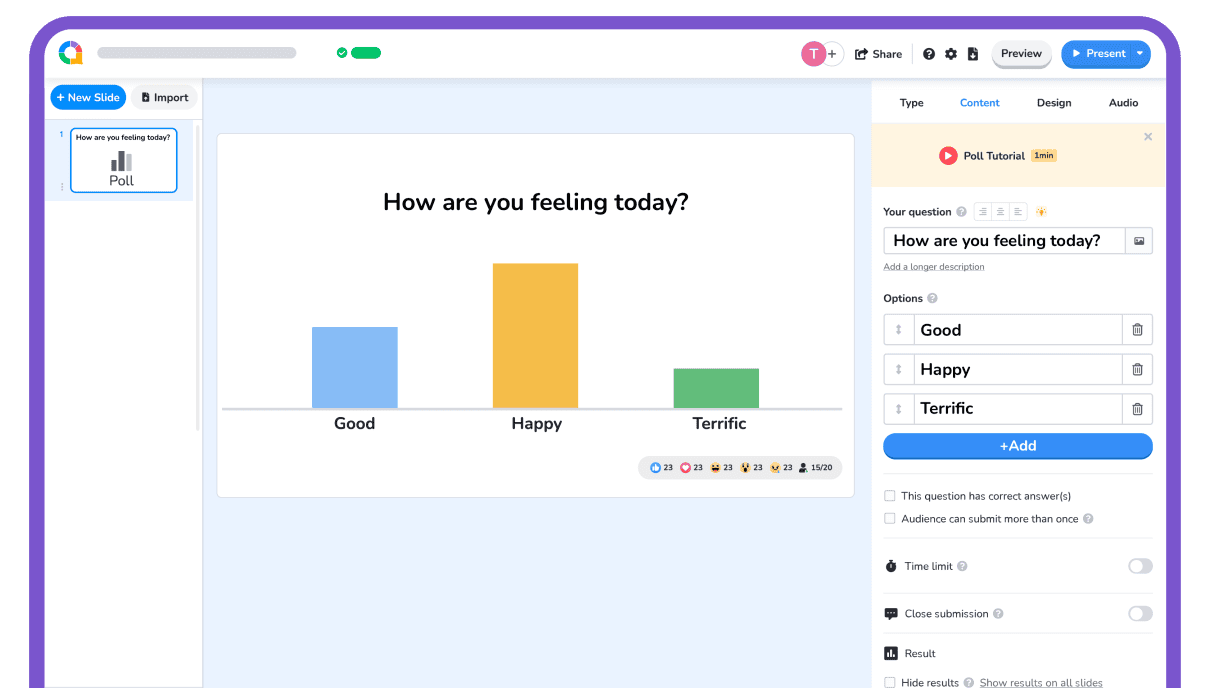
AhaSlides effortlessly integrates quizzes, live polls, and interactive games within your presentations, making spontaneous interactivity easy. No additional hardware or installations are necessary, perfect for on-the-spot classroom feedback.
It’s a bit like Mentimeter, offering a way to involve students during a slideshow, whether you teach live in person or via a screen-share.
Key Features:
- Simple interactive elements: Live polls, quizzes, and games.
- Presentation integration: Integrated with PowerPoint, Google Slides, or standalone presentation mode
- Student access: Immediate access for students via QR code or link, no student accounts needed
Pricing: Free plan supports up to 50 participants with slide limits; Essential plan starts at $7.95/month for expanded features and larger audiences.
12. Vevox
Great for: Extensive, scalable classroom interactions

Vevox is excellent for large-scale classroom polling, quizzes, and moderated discussions. It integrates smoothly with PowerPoint and LMS platforms, making it particularly valuable for larger classes or institutional use.
It might not have the same name recognition in K-12 as the likes of Kahoot!, but it’s a powerful tool especially in lecture settings or even school-wide meetings.
Key Features:
- Dynamic engagement: Live polls, quizzes, and word cloud features
- Discussion support: Moderated Q&A for active discussions
- Presentation integration: Works with PowerPoint, Moodle, and Blackboard
- Large-scale usage: Scalable for large classes or school-wide events
Pricing: Free plan supports up to 100 students with limited features; Starter (Education) plan starts at $7.75/month (billed annually) for advanced tools.
13. Wooclap
Great for: Extensive interactive question variety and collaboration
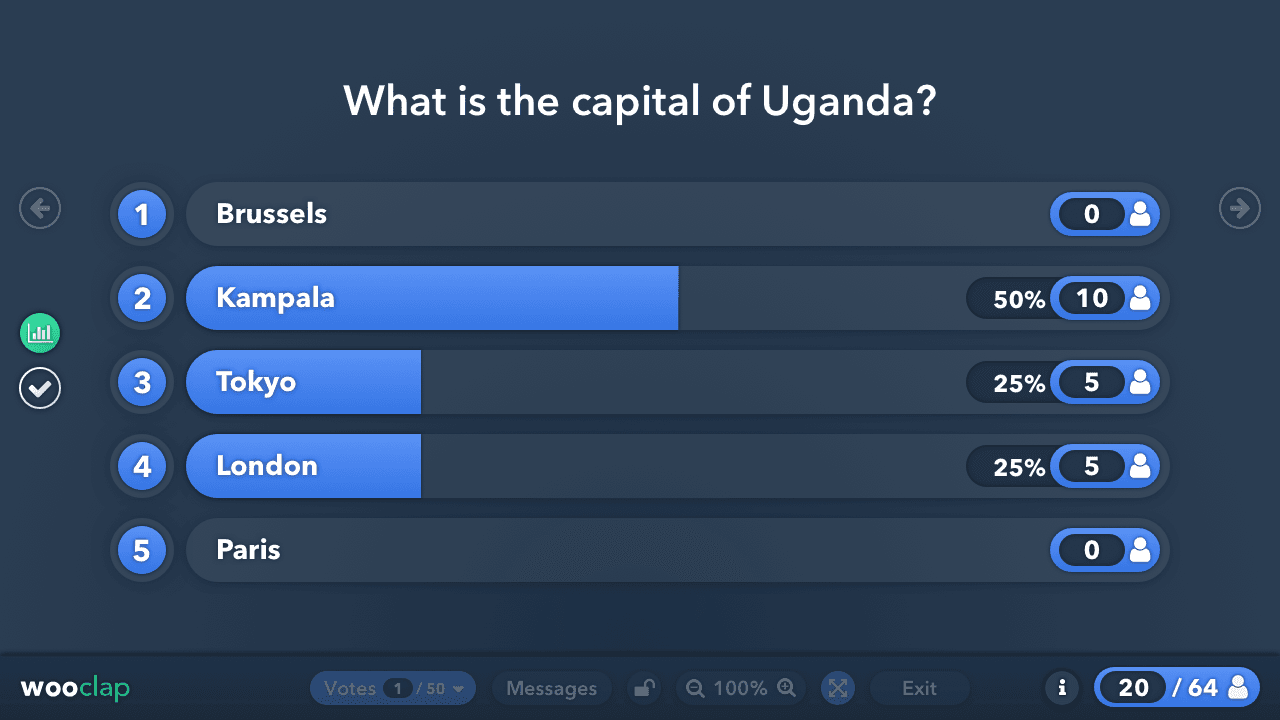
Wooclap, among audience response systems, has always been noted for its wide range of over 21 interactive question types, from multiple-choice to collaborative brainstorming, designed to enhance student participation.
Wooclap’s focus on pedagogy (they even incorporate neuroscience research on attention and memory) sets it apart as a tool not just for one-off fun quizzes, but for systematically increasing student engagement and feedback.
Key Features:
- Question types: Extensive range of interactive question formats
- Collab emphases: Collaboration-focused tools like idea clustering and voting
- Generous free plan: Large-scale use (up to 1,000 participants) even in the free plan
Pricing: Free plan allows up to 1,000 participants but limits sessions to 2 questions; Basic (Education) plan starts at $6.99/month (billed annually) for unlimited questions and advanced tools.
Choosing the Right Tool: A Quick Roundup
Not all audience response systems are created equal, and that’s actually a good thing. With these options on the table, the best audience response system for your classroom depends on how you teach, what devices are available, and the kind of student engagement you’re aiming for. Here’s how to make sense of your choices:
- Best for Seamless Presentation Integration
If you prefer tools that live inside your slides without needing to toggle between apps, go for:
ClassPoint (for PowerPoint), Pear Deck (for Google Slides), Vevox, and AhaSlides. - Best for Fast-Paced, Game-Like Quizzes
Want a spark of competition with points and leaderboards? You’ll feel right at home with:
Kahoot!, Quizizz, and Socrative. - Best for Polling, Feedback, and Discussions
For when you want students to vote, share thoughts, or ask questions in real-time:
Mentimeter, Poll Everywhere, Slido, and Wooclap. - Best for Multimedia-Driven Lessons
If your sessions are more content-heavy or need diverse activity types beyond quizzes:
Nearpod and Wooclap support richer, more interactive lesson formats. - Best for Low-Tech or Limited Device Setups
Need something device-light or for situations where only the teacher has tech access?
Plickers is your go-to.
FAQs
What are some creative ways to use audience response systems beyond quizzes?
Audience response systems can be used for icebreakers, anonymous opinion polls, peer feedback, or quick reflection prompts. Teachers also use them to conduct live debates, track emotional check-ins, or crowdsource ideas for group projects, all while keeping students engaged in real time.
Do audience response systems work for asynchronous learning environments?
Yes. Many modern audience response systems like Nearpod, Quizizz, and Wooclap support student-paced modes. This means students can complete polls or quizzes at their own pace, making these tools effective even outside live sessions or during homework and flipped learning.
How can I choose the best audience response system for my teaching style?
Start by identifying your needs: do you prefer live polls, gamified quizzes, or quiet student reflection? For example, Kahoot! and Quizizz are great for fast-paced reviews, while ClassPoint and Pear Deck blend seamlessly with slide decks. Choose based on your preferred tools, lesson format, and your students’ level of tech access.
Can audience response systems help improve equity and inclusion in class?
Absolutely. Tools like Mentimeter, Slido, and Poll Everywhere allow for anonymous responses, which encourages quieter or more hesitant students to participate. This helps teachers gather a more complete picture of understanding and opinion, without bias toward more vocal students.
Are audience response systems only effective in tech-heavy classrooms?
Not at all. Low-tech options like Plickers are specifically designed for classrooms with limited device access. These tools use printed cards and a teacher’s device to gather responses, ensuring all students can participate regardless of device availability.
Which audience response systems offer the best data export and reporting features?
ClassPoint, Quizizz, and Socrative stand out here. These platforms provide downloadable reports, Excel exports, and class-level insights that help with grading, parent communication, and lesson planning. If tracking student growth over time is a priority, these are strong choices.
How do audience response systems support formative assessment?
They offer instant feedback that helps teachers adjust instruction on the spot. Tools like Socrative and ClassPoint provide real-time reports and performance data, allowing educators to identify misconceptions, spot learning gaps, and plan targeted follow-ups without the wait.
